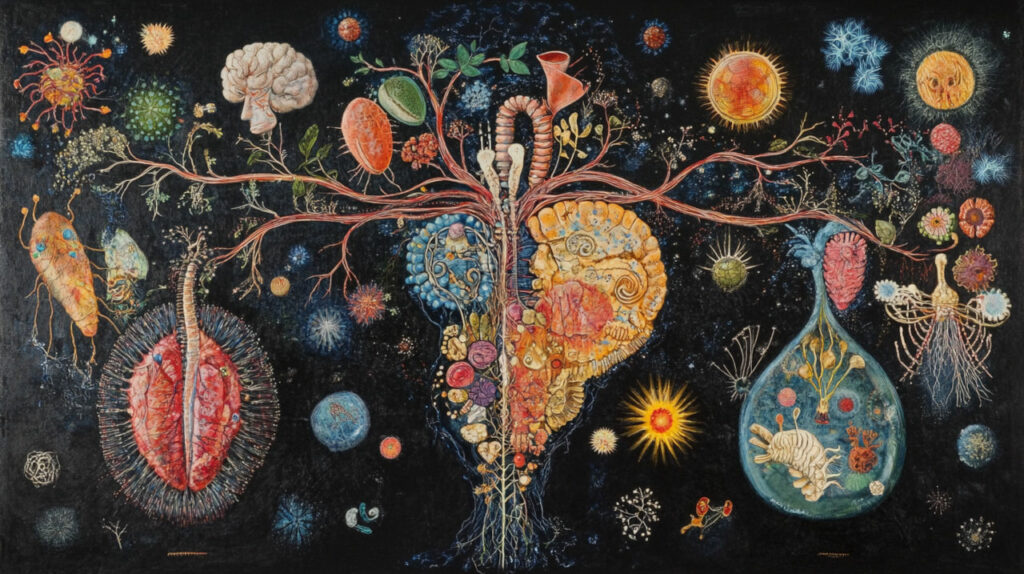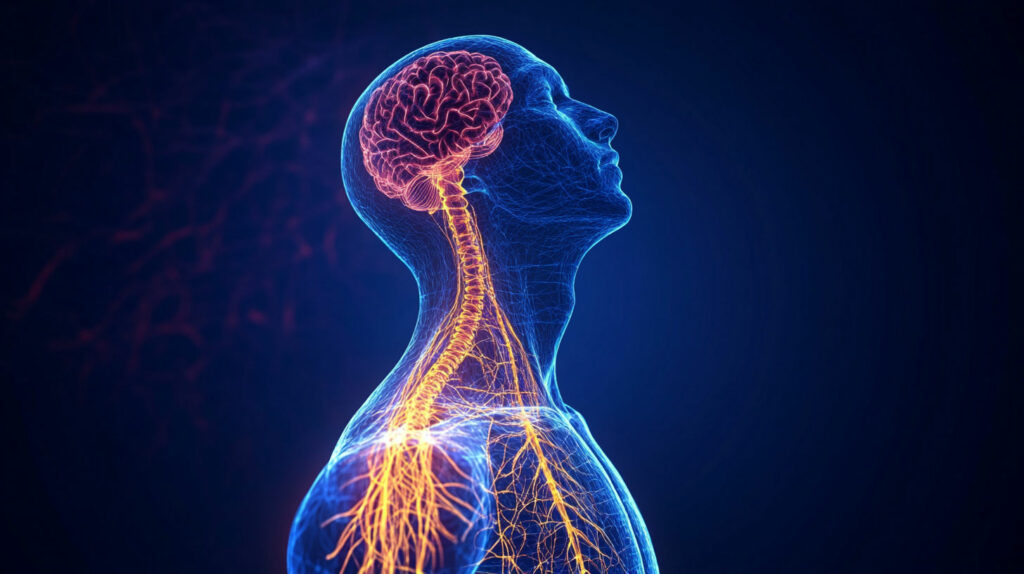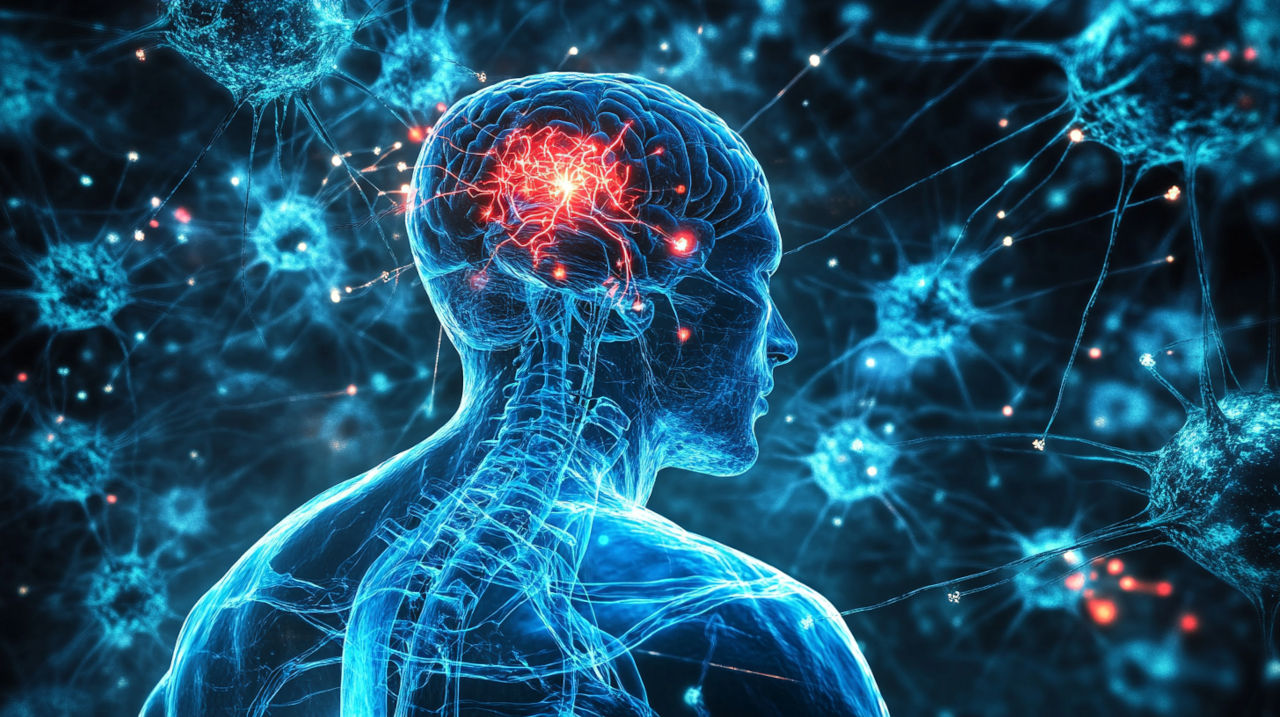For adults with ADHD, the nervous system can easily get stressed and dysregulated. This is doubly true for those who work in high-pressure and stressful jobs like entrepreneurship.
This means trouble. A large percentage of doctor visits are due to stress-related problems. Prolonged stress can wreak havoc across many of our essential bodily systems, from brain to bowl, sleep patterns to immune function.
The doctor might help treat some of the symptoms, but for anyone in a highly stressful situation, the best way to ensure proper functioning and health in the future is to find ways of better managing your own nervous system.
This might mean changing the situation itself—switching jobs, delegating more, moving out of the city—other times you can achieve a lot by adopting new perspectives and behaviours, in effect building a habit of resilience to outside influences and taking greater control over your mind and body.
Understanding the Nervous System

The nervous system is a huge network of nerves and cells connecting all the important organs in your body to your brain, to regulate all your different bodily functions.
If your brain is the control centre, the nervous system is how it communicates with everything else. All your voluntary and automatic processes rely on the nervous system to function properly.
Within the nervous system are various subsystems, including: the central and peripheral, within the peripheral there is the somatic and autonomic, and within the autonomic are the sympathetic and parasympathetic.
Those last two are the most important for the topic of this article.
Sympathetic and Parasympathetic
As mentioned above, the sympathetic (SNS) and parasympathetic (PNS) nervous systems are part of the autonomic system, which regulates involuntary functions and processes.
This means that both the PNS and SNS are controlled largely unconsciously, they tend to operate in the background as you go about your other day-to-day tasks.
The SNS is responsible for the “fight-or-flight” response, getting you ready to deal with stressful or dangerous situations by increasing your heart rate and redirecting blood flow to your muscles.
The PNS, on the other hand, is responsible for the “rest-and-digest” state, slowing heart rate to conserve energy, prompting digestion, calm, and recovery.
While both systems are constantly active at a basic level to maintain homeostasis, when one is more active the other is less so. When you are responding to a stressful event, things like digestion are considered secondary.
The Vagus Nerve and HRV
The vagus nerve is a long and complex cranial nerve that is part of the PNS. It starts at the base of your brain and branches out to many essential organs like your heart and digestive tract.
When you relax after a stressful event, your vagus nerve will send signals throughout your body, telling it to get back to ‘resting-and-digesting’.
A common measure for the health of your nervous system is heart-rate variability (HRV)—how much variation there is in the interval between your heartbeats.
While you might think you want a consistent heart rate, low variability is associated with many significant health issues. Rather, a heart rate that naturally fluctuates is better able to adapt to life’s many demands.
And what regulates your HRV? The vagus nerve.
What’s more, many of the symptoms of ADHD appear connected to HRV. People with ADHD tend to have an overactive SNS (fight-or-flight), reduced vagus nerve activity, and lower heart rate variability.
Effective vagus nerve regulation improves HRV and has many downstream advantages, from better stress and resilience to emotional regulation. Fortunately, there are ways to meet this goal.
Regulating Your Nervous System

Finding the right balance between parasympathetic and sympathetic activity can be troublesome. Many of us spend too long stressing out, tipping the balance in an unhealthy direction.
Getting your nervous back under control is best achieved by targeting the vagus nerve, and there are a few ways to do this:
1. Flow
When you’re in a flow state—also known as being in the zone—you are experiencing a unique sense of both relaxation and focus.
You’re challenged, but in a way that you are in control and completely engaged with the task. There’s no deflationary ego or stressful second-guessing, it’s a positive and rewarding experience.
What research has drawn out and intuition would suggest is that the flow state occupies an optimal balance between sympathetic and parasympathetic nervous system activity.
And while flow can seem an elusive state, there are many strategies for increasing their occurrence within many different settings. You can check out other articles on this website about flow states and ADHD.
2. Vagus Nerve Stimulation
Where the other points on this list are indirect methods of activating your vagus nerve and regulating nervous system activity, there is a much more direct way: vagus nerve stimulation devices.
Depending on the specific device, this could mean electrical or acoustic signals applied to your ear, neck, or other areas of the body, with the purpose of pushing your vagus nerve into action.
Quite a lot of recent research has supported the efficacy of vagus nerve stimulation (VNS).
Older adults who used VNS for two weeks showed improved vagal tone, and better mood and sleep patterns. Another showed that VNS can help with headaches and migraines.
A review of the research on VNS found it promising in treating various chronic inflammatory diseases, and in controlling pain, concluding: “VNS bears the promise of being applied to a wider range of therapeutic applications.”
The Pulsetto is one of the best VNS options you can get today, here’s an article on some of the options available.
3. Biofeedback
Biofeedback also generally requires a device, but one that doesn’t influence the vagus nerve (at least not directly), instead it reads signals from your body and shows you what’s going on.
As you watch these signals you can engage in other tasks and activities to get a better sense of how your body reacts and changes in different situations.
In relation to the health of your nervous system, heart rate variability is likely the key measure. Research has shown that HRV and biofeedback are capable of improving depressive symptoms.
By performing activities and monitoring your HRV via a biofeedback device, you can learn to control your nervous system. With practice, you’ll be able to spot the signs and adjust your mind and body in response.
Then there’s neurofeedback, a form of biofeedback that measures brain activity rather than HRV. It essentially goes right to the top, to the brain signals that can cascade down to the vagus nerve and influence the HRV.
Neurofeedback has also shown numerous benefits for stress reduction and cognitive performance, and can help alleviate symptoms of ADHD.
4. Meditation
If you use biofeedback or neurofeedback devices, you’re likely going to practice mindfulness or other forms of meditation and breathing exercises. But if you don’t have one of those devices, these activities are still powerful.
People have been meditating since before science really developed, but now that we have science, it’s come in to sing the praises of this ancient practice.
It was always quite obvious that meditation was capable of calming and focusing a scattered mind.
What we now know is that it can improve HRV, strengthen your heart health, and optimize the connectivity of certain brain networks which can help with managing stress and anxiety.
There is also evidence that mindfulness can help treat certain physical and psychological problems, including ADHD in adults.
5. Cold Exposure
Most of the points so far are generally positive or relaxing experiences, now to break that pattern. Most people find a cold shower intolerable, so can it really help?
It certainly looks like it. Cold water therapy has been shown to activate the vagus nerve and improve heart rate variability, treat symptoms of depression, give the immune system a boost, and help manage ADHD.
You can take a cold shower, jump in a lake, or sit in a bathtub with ice. There are many ways to do it, but they’ll all involve pushing the temperature to that uncomfortable point.
However, care should be taken not to push it too far, at least until you get more familiar with it. Too much of a shock can cause other problems, so take small steps in the wintery direction.
Controlling the Stress Response

The modern world is full of situations that tend to raise blood pressure and frazzle the mind, and this is all the more true in professions that are unpredictable and subject to risk—entrepreneurs, freelancers, and digital nomads come to mind.
But while the nervous system is broad, complex, and most of its operations happen automatically and beyond our direct control, there are ways to influence it towards improving our health and resilience.
One effective measure is to target the vagus nerve, that highway of fibres stretching out to every important organ in your body and that pushes the body into a rest-and-digest state, counteracting the stressful fight-or-flight state.
In addition, focusing on the vagus nerve will improve your long-term heart rate variability—that dynamic timing between heartbeats that seems to trigger ADHD symptoms when there’s little variation, but can make your body more adaptable to changing demands when it can move.
Anyone looking to get more balance and control in their nervous system has options, so there’s no reason to continue to suffer from the physical and psychological toll any longer.
- 10 Tips, Tricks And Tools To Overcome ADHD Paralysis - March 19, 2025
- 10 Interesting Facts About Adult ADHD And Mental Health - March 18, 2025
- 15 Ways To Manage ADHD Without Meds By Biohacking Dopamine - February 14, 2025


